Creeping thyme, a stunning herbaceous plant with shrub-like qualities, gracefully expands to create a vibrant carpet adorned with purple, red, and pink flowers. This petite perennial herb, known for its aromatic fragrance and low-growing nature, thrives splendidly in sun-kissed garden landscapes. The effortlessly maintained and mat-forming plant, boasting glossy green leaves and clusters of flowers adorning upright shoots, possesses immense value in enhancing the allure of both front and backyards.
While it is possible to cultivate creeping thyme from seeds, acquiring nursery plants offers a simpler alternative. Once the seedlings are nestled into the soil, creeping thyme swiftly blankets bare ground, fills gaps between stepping stones, or drapes over retaining walls and containers. Once established in your garden, this diminutive shrub resembling a blanket bursts into bloom every spring and summer, painting your surroundings with an array of pink, red, or purple blossoms.
This piece serves as an introduction to the mesmerizing world of creeping thyme and its diverse array of colorful cultivars. Descriptions and images showcasing the delicate pinkish-purple flowers of creeping thyme, along with guidance on planting and care, will assist you in selecting how to incorporate this herbaceous perennial shrub into your landscape.
A Glimpse into Creeping Thyme (Thymus spp.)
Creeping thyme, a perennial flowering shrub, gracefully expands to form a captivating expanse of purple, pink, or red flowers. As a dwarf shrub with a low-growing nature, creeping thyme belongs to the shrub genus Thymus and shares its lineage with plants in the Lamiaceae family, commonly known as the mint family.
Characterized as a spreading shrub with a prostrate growth habit, creeping thyme stands at a modest height of up to 3″ (7.5 cm), boasting creeping woody stems that extend up to 24″ (60 cm) in length. This self-seeding subshrub quickly covers the ground, adorning gardens with densely clustered, strongly scented flowers.
The flowers of creeping thyme are small, bell-shaped blossoms typically sporting shades of pink-purple, magenta, or lilac. Some exceptional varieties even showcase white blooms. These tubular pinkish-purple flowers measure between 0.15″ and 0.23″ (4 – 6 mm) in length. As late spring and early summer roll around, creeping thyme transforms into a splendidly colorful flowering carpet.
One of the remarkable features, and a reason for cultivating creeping thyme, lies in its highly fragrant flowers and foliage. The floral scents emitted by the plant range from herbal to intensely lemony, with a citrusy variation known as orange-scented creeping thyme.
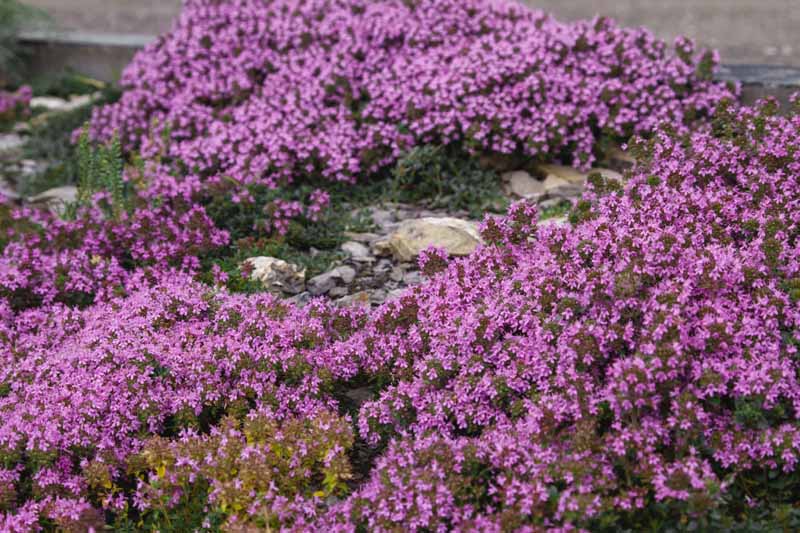
Referred to as the “Mother of Thyme,” creeping thyme boasts numerous applications in garden landscapes within USDA zones 4 through 9. This ground-spreading plant serves as an excellent ground cover, border plant, flowering container plant, or addition to rock gardens, enhancing stone paths with its charming presence.
Various types of ground cover thyme plants fall under the category of evergreen perennials. This classification implies that these flowering woody shrubs retain their foliage throughout the year in regions with mild winters. In colder climates, however, thyme behaves as a perennial, receding to the ground in winter and reemerging in spring.
One of the advantages of ground creeping thyme shrubs lies in their suitability as a substitute for bluegrass in xeriscape landscapes. These hardy, low-growing shrubs endure moderate foot traffic and exhibit tolerance towards poor soils and drought.
Additional intriguing facts about creeping thyme include its small, aromatic, edible leaves boasting a minty flavor. Furthermore, this herb
aceous plant exudes a scent that repels deer, attracts pollinators such as bees, and requires minimal care to thrive.
Types of Creeping Thyme (Accompanied by Visuals) – An Identification Guide
Creeping thyme ranks among the finest ground cover plants for your garden landscape, effortlessly extending its reach to envelop vast expanses of bare ground. To aid in the identification of the various creeping thyme cultivars and discover additional options for full-sun flowering ground covers, please continue reading.
Creeping Thyme (Thymus serpyllum)
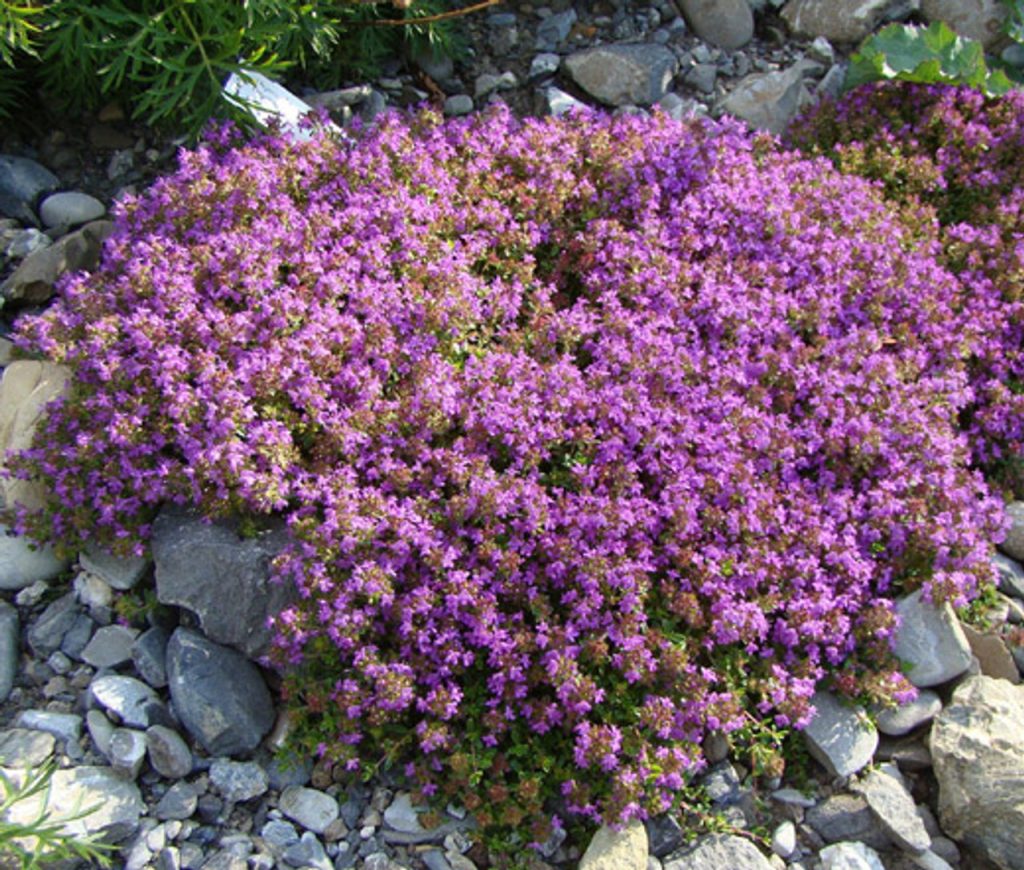
Creeping thyme, a perennial plant with a low growth habit, delights with its purple-pink flowers that flourish in full sun. This visually appealing ground cover showcases pink or purple-lavender flowers, forming a splendid tapestry of green foliage and purplish blooms. Growing to a height of 3″ (7.5 cm) and spreading up to 12″ (30 cm) in width, creeping thyme thrives in full sun.
Expanding rapidly through its rooting stems, creeping thyme is a herbaceous perennial that thrives in USDA zones 4 to 9, necessitating at least six hours of sunlight to thrive. Its delicate pink blooms attract butterflies, bees, and other pollinators throughout late spring and early summer.
With its low-maintenance and ground-hugging nature, creeping thyme serves as an ideal landscaping plant for filling the gaps between paving stones, adorning borders, gracing containers, cascading over retaining walls, or trailing from window boxes.
The pleasant fragrance emanating from purple-flowering creeping thyme makes it a perfect choice for planting along pathways or between stepping stones, releasing a delightful aroma when crushed by foot traffic.
Red Creeping Thyme (Thymus serpyllum ‘Coccineus’)
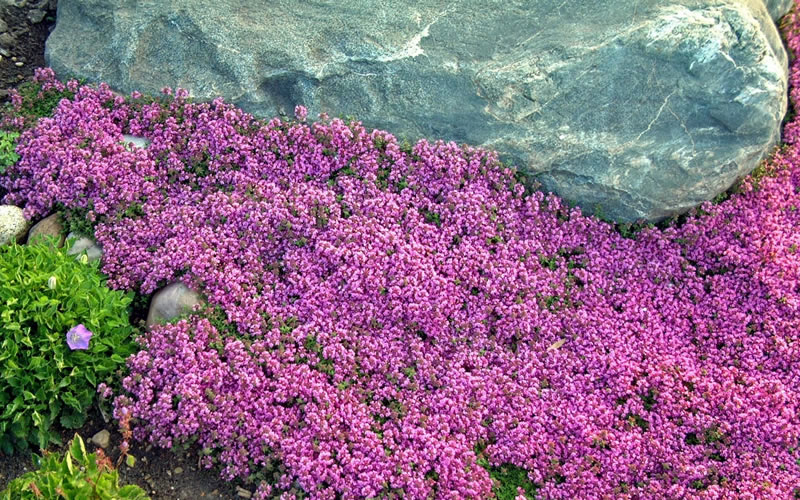
Red creeping thyme, a spreading perennial herb, forms a low mound of tubular deep pink flowers and glossy green foliage. This red-flowering ground cover thrives in early to late summer, engulfing itself in masses of vibrantly colored deep pink blossoms. Growing to a height of 3″ (7.5 cm) and spreading up to 12″ (30 cm) in width, this semi-evergreen plant stands out with its small, rounded, shiny green aromatic leaves that exude a fragrant herbal scent. The magenta-red blooms appear as tiny bell-shaped flowers adorning wiry stems in small clusters.
Suitable for planting in USDA zones 4 to 9, red creeping thyme flourishes best in full sun, although it tolerates partial shade. In addition to its breathtaking hues, this ground cover possesses the ability to withstand drought and poor soils, making it a valuable addition to any landscape.
Red creeping thyme thrives as a ground cover plant between stepping stones, releasing pleasant scents when crushed by foot traffic. It also serves as an excellent choice for border planting, rock gardens, and adding splashes of color to various landscapes. Moreover, it presents an alternative lawn option for areas bathed in full sun.
Elfin Creeping Thyme (Thymus serpyllum ‘Elfin’)
The ‘Elfin’ cultivar of creeping thyme is a miniature, low-spreading shrub showcasing an abundance of lavender-pink flowers that blend harmoniously with pink and green hues. This petite, mat-forming shrub reaches a height of 1″ to 3″ (2.5 – 7.5 cm) and spreads up to 18″ (45 cm) in width. The spreading plant boasts fragrant oval leaves.
‘Elfin’ creeping thyme, an evergreen perennial, finds its home in USDA zones 4 to 9. Flourishing in xeric landscapes and adapting well to poor soils in urban settings, this ground-hugging shrub requires minimal care and maintenance.
Apart from serving as ground cover in full sun, the pink-flowering ‘Elfin’ creeping thyme offers several landscaping possibilities. It serves as an exquisite edging plant along driveways or flower beds and makes a stunning addition to containers, with its trailing stems gracefully spilling over the edges.
White Flowering Creeping Thyme (Thymus serpyllum ‘Albus’)

‘Albus’ creeping thyme emerges as an enchanting low-growing plant, enveloping the ground in a soft mat of light green foliage and small white flowers that persist throughout the summer. White-flowering creeping thyme is relatively rare. This attractive flowering shrub can reach a height of up to 12″ (30 cm) and spreads up to 20″ (50 cm) in width.
The small star-shaped white flowers become the focal point of ‘Albus’ creeping thyme, creating a vividly covered cushion on the ground. The tiny dark green oval leaves beautifully contrast with the white blossoms. This white creeping thyme also complements red or pink thyme ground cover plants when planted alongside them.
Ideal for patio settings when cultivated in containers, white-flowering creeping thyme lends itself well to rock gardens, borders, and as a front-of-foundation-plantings texture enhancer.
Creeping Thyme ‘Pink Chintz’ (Thymus serpyllum ‘Pink Chintz’)
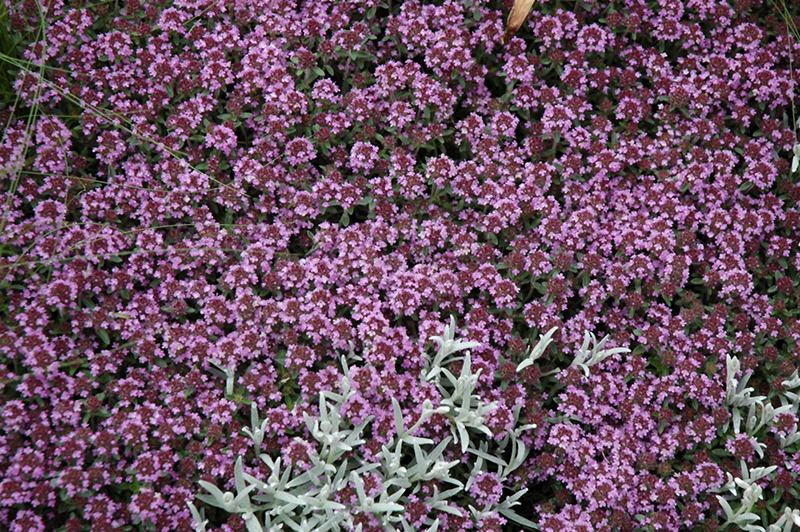
‘Pink Chintz,’ a cultivar of creeping thyme, represents a compact, perennial low-growing shrub with a ground-hugging nature. This creeping thyme variety boasts tiny, slightly fuzzy, dark green aromatic leaves and small, pale pink starry flowers. The low-mounding ground cover plant reaches a height of 2″ (5 cm) and spreads up to 12″ (30 cm) in width.
Thriving in full sun and blooming profusely during summer, the ‘Pink Chintz’ creeping thyme cultivar entices with its delicate pale pink flowers that attract pollinators and bees. Additionally, its slightly woolly leaves emit a woody fragrance when crushed. This low-mounding ground cover plant finds its home in USDA zones 5 to 9.
As with most varieties of miniature spreading thyme plants, the ‘Pink Chintz’ cultivar proves to be an excellent choice for edging pathways, filling gaps between stepping stones, or enhancing the charm of rock gardens. Moreover, the trailing woody stems and fuzzy leaves beautifully cascade over containers and tall planters.
Creeping Thyme ‘Magic Carpet’ (Thymus serpyllum ‘Magic Carpet’)
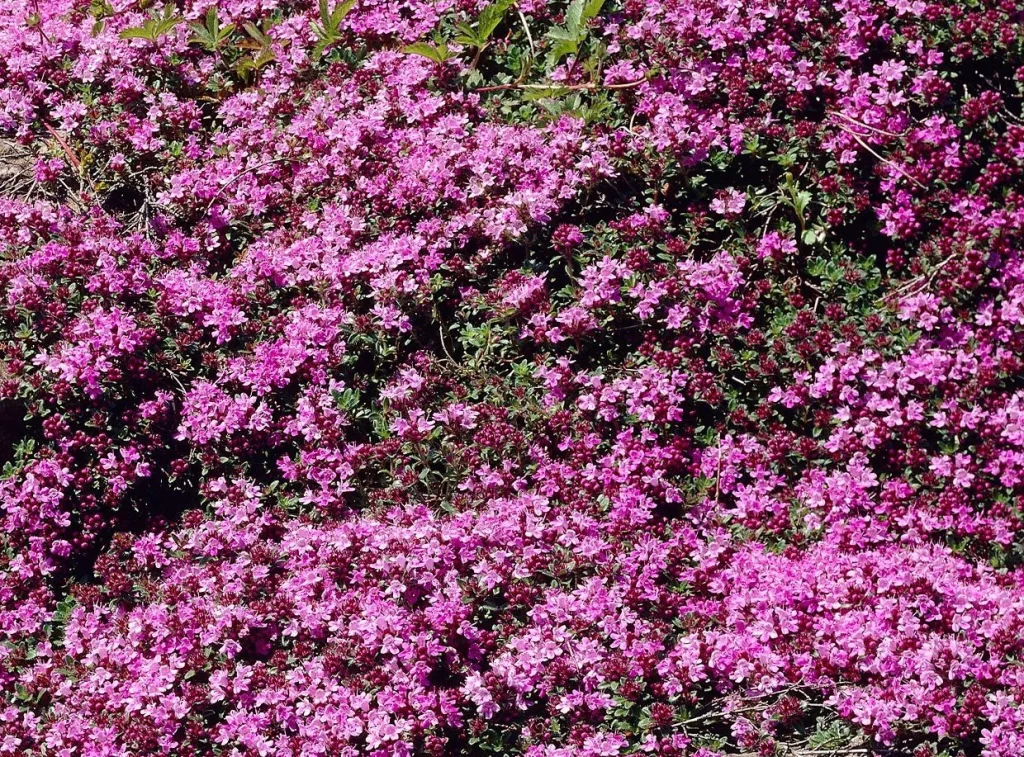
The ‘Magic Carpet’ cultivar of creeping thyme manifests as a low-growing aromatic shrub, forming a dense mat of tiny, rounded, glossy dark green leaves adorned with clusters of bright magenta-pink flowers. The stunning flowers, with their five rounded pink petals, assume the shape of an open cup. The dark green foliage also doubles as a suitable alternative for lawns.
‘Magic Carpet’ creeping thyme is predominantly employed as an understory or ground cover plant, boasting profuse blooms from early spring through summer. When in full bloom, this ground cover cultivar transforms into a spectacular carpet of bright pink, starry flowers. Plant this ground cover in full sun, allowing it to flourish in well-drained soils within USDA zones 4 to 9.
Landscaping ideas for the ‘Magic Carpet’ ground cover thyme include adding texture to front-of-house plantings, edging flower beds, or illuminating driveways with pink blossoms. It also thrives when planted in containers, with trailing stems cascading over the edges of planters.
Purple Creeping Thyme (Thymus praecox)
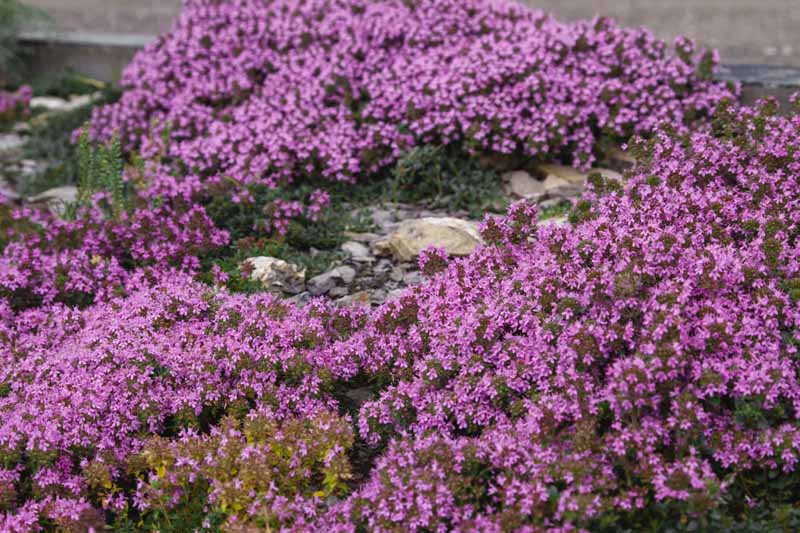
Purple creeping thyme emerges as an alluring perennial herbaceous plant, characterized by horizontally spreading flowering woody stems. This purple-flowering specimen stands out due to its aromatic dark green leaves, vibrant pink tubular blooms, and creeping growth habit. The carpet-forming creeping thyme can grow anywhere between 3″ to 6″ (7.5 – 15 cm) in height and spreads up to 12″ (30 cm) in width.
Prominent features of purple creeping thyme include its captivating foliage color, extended flowering period, and its ability to withstand poor soils and drought.
This low-growing plant thrives as a border or edging plant, ground cover, and mounding specimen that attracts pollinators. Additionally, its compact nature makes it a perfect choice for compact gardens, slopes, edging walkways and lawns, and container gardening.
Purple creeping thyme also offers variations with white flowers (Thymus praecox ‘Albus’) and red flowers (Thymus praecox ‘Coccineus’), also known as ‘red creeping thyme.’
Orange-Scented Thyme (Thymus x citriodorus ‘Spicy Orange’)
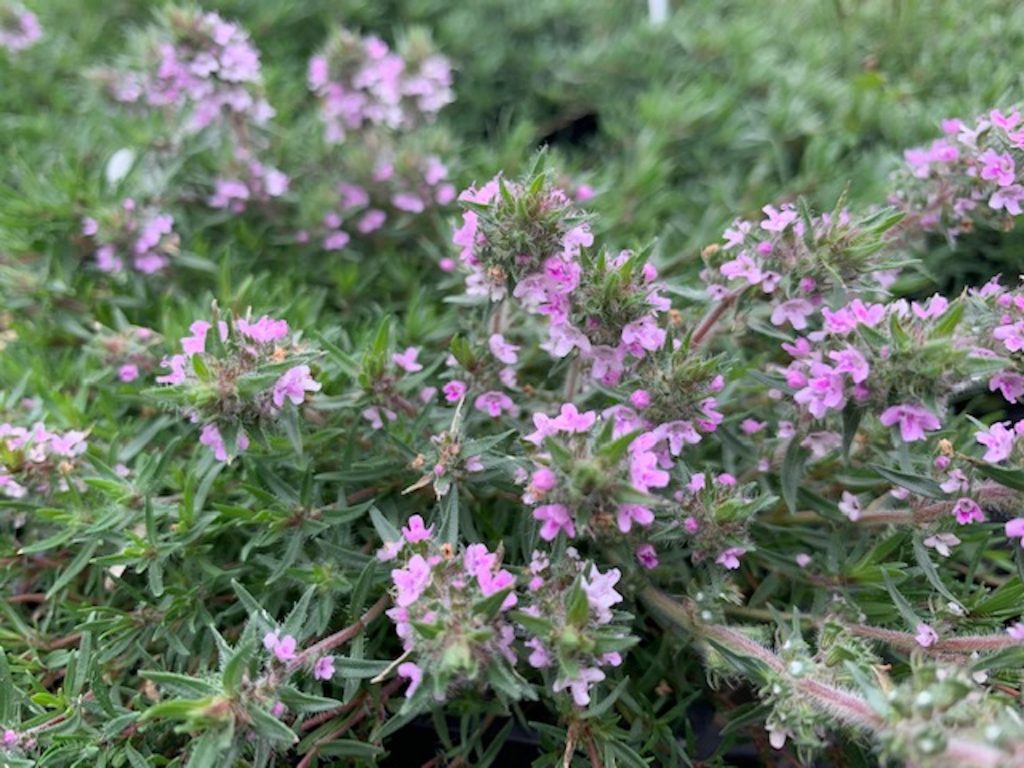
Orange-scented thyme presents itself as an easily cultivated ground cover perennial, distinguished by its needle-shaped aromatic leaves and clusters of lavender-pink flowers. As the name implies, the slender, linear leaves of the ‘Spicy Orange’ thyme cultivar carry a distinct orange fragrance. This ornamental garden plant requires minimal effort and thrives as ground cover in USDA zones 5 to 9.
Reaching a height of 2″ to 4″ (5 – 10 cm) and spreading up to 12″ (30 cm) in width, ‘Spicy Orange’ creeping thyme spreads through its rooting stems and exhibits moderate growth. The pale pink flower clusters serve as a delightful contrast against the dark green foliage, which grows sparsely on upright stems.
Landscaping possibilities for orange-scented thyme include edging, full-sun ground cover, lawn alternative, and filling spaces between stepping stones or cracks.
The ‘Spicy Orange’ thyme cultivar thrives in USDA Zones 8 through 10.
Creeping Woolly Thyme (Thymus pseudolanuginosus)

Creeping woolly thyme, a mat-forming ground cover plant, showcases fuzzy leaves and pale pink flowers. This perennial herbaceous plant stands out due to its densely packed, hairy foliage. Pictures of creeping woolly thyme aptly illustrate how it earned its name. The bright green oval leaves feature fine, long hairs, imparting a soft, fuzzy appearance to this low-growing plant.
Boasting dense evergreen foliage, creeping woolly thyme also blooms with masses of pale pink flowers in early summer. In warmer-winter regions, the foliage of this perennial adopts pinkish tones, ensuring year-round visual interest.
Reaching a height of only 3″ (7.5 cm) and spreading up to 12″ (30 cm) in width, this fuzzy thyme variety adds texture and color to rock gardens, edges, and flower bed borders. It thrives as a filler between stepping stones and beautifully trails over ledges and containers.
Broad-Leaved Lemon Thyme (Thymus pulegioides)
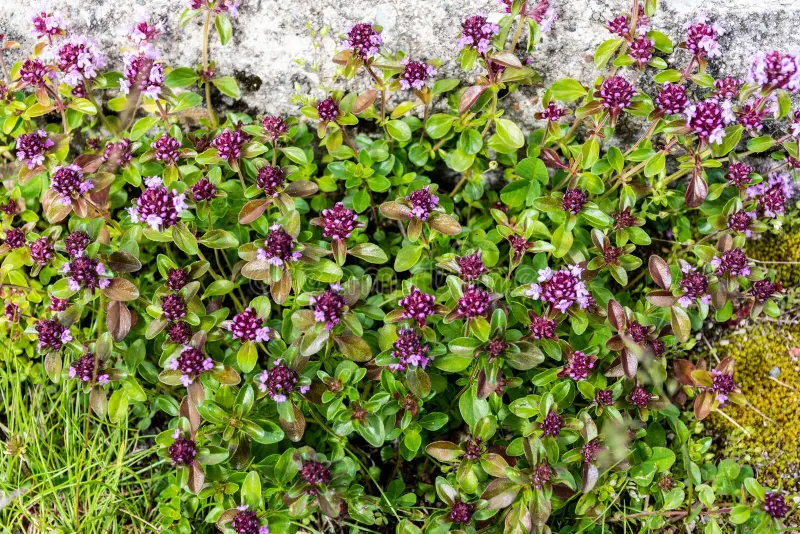
Broad-leaved lemon thyme emerges as a low-growing subshrub with semi-woody horizontally spreading stems adorned with aromatic herbaceous leaves and pinkish-pale purple tubular flowers. Certain eye-catching cultivars of creeping lemon thyme boast variegated green leaves with creamy-white
or golden margins. The ground cover’s tubular rose-purple blooms measure around 0.25″ (0.6 cm).
Thriving in USDA zones 4 to 8, creeping lemon thyme grows to a height of 8″ to 12″ (20 – 30 cm) and spreads just as wide. This mounding ground cover is known for its exceptionally fragrant leaves, which exude a distinct citrusy aroma.
While broader in appearance compared to other low-growing thyme varieties, broad-leaved lemon thyme proves suitable for perennial ground cover. It also serves as a charming pink-flowering addition to containers, patios, sunny balconies, and a variety of other garden settings.
How to Cultivate Thyme from Seeds
Growing thyme from seeds can pose a challenge, as they require time to germinate. Here are some useful tips if you’re interested in planting creeping thyme seeds.
Sow creeping thyme seeds indoors during late winter or early spring, utilizing a seed-starting container filled with seed-sowing compost. Scatter a few seeds over the surface and lightly cover them with soil. Mist the soil, cover the pot with plastic to increase humidity, and place it in a warm location for germination.
Germination of thyme seeds usually takes approximately 3 weeks. Once the threat of frost has passed and the thyme seedlings reach a height of 4″ (10 cm), they can be transplanted into the ground.
Space the creeping thyme seedlings 8″ to 12″ (20 – 30 cm) apart, allowing the spreading stems ample room to grow to their full size. During the first year, water the purple-flowering ground cover plants twice a week for two to three months to facilitate root establishment.
The ideal location for planting creeping thyme in your garden is a sunny spot with moderately fertile, well-drained soil. While creeping thyme exhibits slower growth during the first year, it will rapidly spread across the ground from the second year onward.